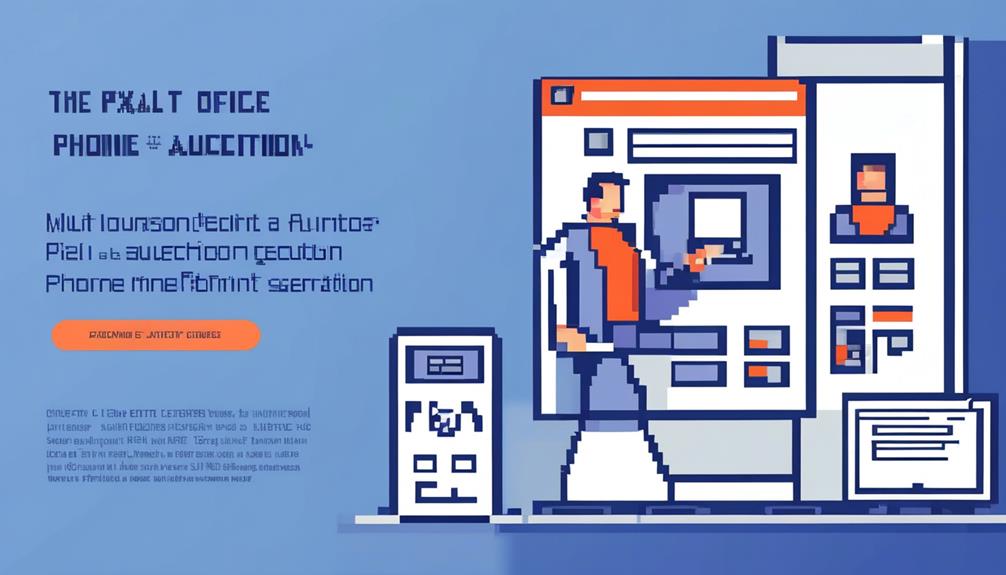In today's interconnected world, the security of PBX systems is of paramount importance. With the increasing number of cyber threats and the potential for unauthorized access, businesses need to take proactive measures to enhance the security of their PBX systems.
This discussion aims to explore various strategies and best practices to safeguard PBX systems against potential vulnerabilities and attacks. By implementing these measures, businesses can ensure the confidentiality, integrity, and availability of their communication infrastructure.
So, let's delve into the world of PBX security and discover how organizations can fortify their systems to protect against evolving threats.
Key Takeaways
- Implementing a firewall and intrusion detection system is crucial for protecting against unauthorized access and malicious activities.
- Regularly updating and patching the PBX software helps address known vulnerabilities and reduces the risk of unauthorized access.
- Strong user authentication mechanisms, such as two-factor authentication, should be implemented to prevent unauthorized access and mitigate password-related vulnerabilities.
- Network segmentation should be utilized to isolate the PBX system and apply strict access controls, minimizing the risk of unauthorized access.
PBX Security Threats

PBX security threats encompass a range of potential risks and vulnerabilities that can compromise the integrity and confidentiality of a PBX system. To ensure the security of a PBX system, there are several aspects that need to be considered.
Firstly, the presence of a firewall is crucial to protect against unauthorized access and malicious activities. A properly configured firewall can block unauthorized connections and filter incoming and outgoing traffic, minimizing the risk of potential threats.
Intrusion blocking is another important measure to enhance PBX security. By implementing intrusion detection and prevention systems, suspicious activities can be detected and blocked, preventing unauthorized access to the PBX system.
Geo Firewall blocking is an effective way to prevent attacks originating from specific geographical regions. By blocking traffic from high-risk countries or regions, the likelihood of targeted attacks can be significantly reduced.
Keeping the PBX system up-to-date with the latest versions of libraries and the operating system is essential to address any known vulnerabilities. Regular updates ensure that security patches are applied, reducing the risk of exploitation by potential attackers.
Additionally, verifying the security of the SSL connection is crucial to protect against eavesdropping and data interception. Implementing strong encryption protocols and regularly checking the validity of SSL certificates helps ensure the confidentiality and integrity of communication within the PBX system.
Common PBX Vulnerabilities
Are you aware of the vulnerabilities commonly found in PBX systems? Understanding these vulnerabilities is crucial in implementing effective security measures to protect your PBX system from potential threats. Let's take a closer look at some of the common PBX vulnerabilities and the corresponding security measures that can be taken to mitigate these risks.
| Common PBX Vulnerabilities | Security Measures |
|---|---|
| Unsupported versions of PBX components | Regularly update and patch PBX components to ensure they are running on the latest versions. Unsupported versions can have known vulnerabilities that can be exploited by attackers. |
| Geo Firewall | Implement a Geo Firewall to block requests from unwanted countries or regions. This can help prevent unauthorized access attempts from locations that are known to be sources of malicious activities. |
| Weak authentication mechanisms | Implement robust authentication mechanisms, such as strong passwords and multi-factor authentication (MFA). Strong passwords should be complex, unique, and regularly changed. MFA adds an extra layer of security by requiring additional verification steps. |
| Lack of secure transport protocols | Ensure VoIP PBX systems use secure transport protocols like Transport Layer Security (TLS) or Secure Real-time Transport Protocol (SRTP). These protocols encrypt communications, safeguarding the confidentiality and integrity of data transmitted over the network. |
| Insufficient network segmentation | Implement network segmentation to isolate the PBX system from other network segments. This helps minimize the risk of unauthorized access and potential security breaches. Additionally, segmenting the network can help contain the impact of a breach should one occur. |
Importance of PBX System Security

Understanding the vulnerabilities commonly found in PBX systems is crucial in recognizing the importance of implementing robust security measures to protect the integrity and confidentiality of your communications infrastructure. A secure PBX system is essential to safeguarding sensitive information and preventing unauthorized access.
Here are three key reasons why ensuring PBX system security should be a top priority:
- Protection against Attacks: PBX systems are susceptible to various types of attacks, including SSH, SIP, and HTTP attacks. Implementing security measures such as firewall configurations and intrusion detection systems can help defend against these attacks. Regularly updating and patching the PBX software is also essential to mitigate security vulnerabilities and reduce the risk of unauthorized access.
- Authentication Mechanisms: Implementing strong authentication mechanisms is crucial to prevent unauthorized access to the PBX system. This includes using strong passwords and enabling multi-factor authentication (MFA). MFA adds an extra layer of security by requiring users to provide additional verification, such as a one-time password or a biometric factor.
- Encryption of Voice Traffic: To ensure the confidentiality and integrity of communications, it is essential to use secure transport protocols such as Transport Layer Security (TLS) or Secure Real-time Transport Protocol (SRTP) for VoIP PBX systems. These protocols encrypt voice traffic, making it difficult for attackers to intercept and decipher sensitive information.
In addition to these measures, network segmentation plays a crucial role in enhancing PBX system security. By isolating the PBX system from other network segments and applying strict access controls, the risk of unauthorized access is minimized.
Securing Your PBX Against Unauthorized Access
To secure your PBX against unauthorized access, it is crucial to implement access control measures and authentication protocols.
Utilize firewall presence, intrusion blocking, and geo firewall blocking to enhance security.
Additionally, enforce strong authentication mechanisms like multi-factor authentication and use secure transport protocols such as TLS or SRTP to further protect your PBX system.
Access Control Measures
To enhance the security of your PBX system and protect against unauthorized access, it is crucial to implement robust access control measures. Here are some key access control measures that can be implemented to enhance PBX security:
- Implement strong password policies and change default ports: By enforcing strong password policies and changing default ports, you can enhance access control to the PBX system and prevent unauthorized access.
- Regularly update and patch PBX software: Keeping your PBX software up to date is essential to mitigate security vulnerabilities and protect against unauthorized access.
- Utilize firewall whitelisting and change default ports: Implementing firewall whitelisting for web access and changing default ports for PJSIP, SIP devices, and SSH can add an extra layer of security to your PBX system.
Authentication Protocols
One effective measure for securing your PBX against unauthorized access is the implementation of robust authentication protocols. Implementing strong password policies is crucial to prevent unauthorized access to the PBX. Consider using multi-factor authentication (MFA) to add an additional layer of security for user logins.
Utilizing robust authentication mechanisms such as TLS or SRTP ensures secure transport protocols. Regularly reviewing and updating encryption settings is vital to maintain the confidentiality and integrity of communications.
Network segmentation can also be considered to isolate the PBX system from other network segments and minimize the risk of unauthorized access.
Implementing Strong User Authentication

To enhance the security of your PBX system, implementing strong user authentication is essential.
Two-factor authentication (2FA) provides an additional layer of protection by requiring users to provide two forms of identification, such as a password and a unique code sent to their mobile device.
Role-based access control (RBAC) allows you to assign specific privileges to different user roles, ensuring that only authorized individuals have access to sensitive features and data.
Two-Factor Authentication
Implementing two-factor authentication is a crucial step in strengthening user authentication and enhancing the overall security of the PBX system. This security measure adds an extra layer of protection by requiring users to provide two forms of identification before granting access. It typically involves something the user knows, like a password, and something the user has, like a mobile phone for receiving a one-time code.
Benefits of implementing two-factor authentication include:
- Increased security: Two-factor authentication helps prevent unauthorized access, even if a password is compromised.
- Protection against various threats: It enhances the overall protection of the PBX system by mitigating the risks associated with password-related vulnerabilities.
- Compliance with security best practices: Two-factor authentication is a recommended security measure in many industries and aligns with industry standards and regulations.
Role-Based Access Control
After implementing two-factor authentication to enhance user authentication and strengthen the security of the PBX system, the next step is to enforce role-based access control for implementing strong user authentication measures. Role-based access control (RBAC) is a security model that assigns specific privileges and permissions to different users based on their roles within an organization. By implementing RBAC, organizations can ensure that users only have access to the resources and actions that are necessary for their job responsibilities. This helps prevent unauthorized access and reduces the risk of data breaches. RBAC can be implemented by assigning roles to users, defining permissions for each role, and then mapping users to their respective roles. The following table illustrates an example of RBAC implementation for a PBX system:
| Role | Permissions |
|---|---|
| Administrator | Full access to all PBX settings and features |
| Manager | Access to call logs and user management |
| Receptionist | Access to call routing and voicemail |
| User | Access to personal extension settings |
| Guest | Limited access for external users |
Role-Based Access Control for PBX Users
Role-Based Access Control for PBX Users provides a robust and secure method of assigning specific privileges and managing varying levels of access within the PBX system. By implementing role-based access control, organizations can ensure that each PBX user is granted the appropriate level of access based on their roles and responsibilities.
Here are some key considerations for role-based access control for PBX users:
- Define user roles: Create different user roles such as Super Admin, Administrator, and Customer User to effectively manage access and control within the PBX system. Each role should have specific permissions and limitations based on their responsibilities.
- Assign and manage user permissions: Use the PBX Web GUI to assign and manage user permissions. The Super Admin should have the authority to control access to different features and functionalities within the PBX system. Regularly review and update user permissions to maintain the security and integrity of the PBX system.
- Use User Portal for extension users: The User Portal is a user-friendly interface that provides extension users with access to their own settings and call detail records. Limit their access to sensitive system configurations while providing them the necessary tools to manage their own extensions.
In addition to these role-based access control measures, it is important to follow industry best practices to enhance PBX security. Consider implementing strong passwords, changing the default port number, and keeping the PBX system updated with the latest security patches. Stay informed about the latest security threats and potential vulnerabilities by following security blogs and forums. Intrusion detection systems can also be deployed to monitor and protect the PBX system from unauthorized access attempts.
Role-Based Access Control for PBX Users is an effective way to manage access and control within the PBX system. By defining user roles, assigning appropriate permissions, and utilizing the User Portal, organizations can ensure the security of their PBX system while providing a flexible solution for their users. Follow industry best practices and stay informed about the latest security measures to protect against potential security threats.
Regular Security Updates and Patching for PBX

Regular security updates and patching for PBX systems are essential to maintain the integrity and security of the telephony infrastructure.
By regularly monitoring vendor's security advisories and promptly applying patches, organizations can mitigate potential vulnerabilities and minimize the risk of unauthorized access.
Implementing best practices, such as keeping PBX software up to date and utilizing robust authentication mechanisms, ensures that the PBX system remains protected against emerging threats.
Importance of Updates
Regularly updating PBX software is crucial for maintaining a secure and protected system against potential security vulnerabilities and threats. By staying informed about the latest security patches and updates from the PBX vendor, organizations can ensure their system remains secure. Here are three reasons why regular updates are important:
- Mitigate security vulnerabilities: Applying patches promptly to the PBX system helps address any identified security vulnerabilities. This reduces the risk of unauthorized access, data breaches, and other security incidents.
- Stay updated on potential risks: Continually monitoring the vendor's security advisories allows organizations to stay informed about potential security risks and improvements. This knowledge enables proactive measures to be taken to protect the PBX system.
- Follow best practices: Following best practices for patch management ensures that the PBX system remains secure and protected. This includes regularly reviewing and testing updates before deployment to minimize any potential issues or disruptions.
Patching Best Practices
Implementing effective patching practices is essential for maintaining the security and integrity of a PBX system. Regularly monitoring the vendor's security advisories for PBX software updates and patches is crucial. It is important to apply patches promptly to mitigate security vulnerabilities.
Staying informed about the latest security patches and updates from the PBX vendor is necessary to keep the system up to date. Following best practices for patch management ensures that the system remains secure.
Additionally, regularly reviewing and updating encryption settings for secure transport protocols like TLS or SRTP adds an extra layer of security. Access control measures should also be implemented to restrict unauthorized access to the PBX system.
Strong user authentication methods need to be in place to ensure that only authorized users can access the system.
Utilizing Secure Transport Protocols for PBX Communication
To enhance the security of PBX communication, it is recommended to employ secure transport protocols. These protocols ensure that data transmitted between PBX systems and other devices is protected from unauthorized access and interception. By using secure transmission protocols, organizations can safeguard their sensitive information and prevent potential security breaches.
Here are three key benefits of utilizing secure transport protocols for PBX communication:
- Data encryption: Secure transport protocols, such as Transport Layer Security (TLS) and Secure Real-time Transport Protocol (SRTP), use advanced encryption methods to secure data during transmission. TLS encrypts the communication channel between PBX systems, ensuring that the information exchanged remains confidential and cannot be easily deciphered by attackers. SRTP encrypts the audio traffic, preventing eavesdropping and ensuring the privacy of voice calls.
- Authentication: Secure transport protocols provide mechanisms for mutual authentication, allowing PBX systems to verify the identity of each other before establishing a connection. This ensures that only trusted devices can communicate with the PBX, reducing the risk of unauthorized access and potential attacks.
- Integrity protection: Secure transport protocols include mechanisms to ensure the integrity of the transmitted data. This means that any modifications or tampering attempts made to the data during transit will be detected, alerting the receiving party of a potential security breach.
Network Segmentation for Enhanced PBX Security

Network segmentation is a crucial strategy for enhancing the security of PBX systems. By implementing network segmentation, organizations can isolate the PBX system from other network segments, reducing the risk of unauthorized access. This is achieved by creating separate zones specifically designated for voice traffic, administrative tasks, and other services, minimizing potential security breaches.
One of the key benefits of network segmentation is the ability to apply strict access controls between segments. By implementing access control lists and firewalls, organizations can limit communication pathways to only authorized traffic, preventing unauthorized access to the PBX system. This helps to ensure that only legitimate users and devices can interact with the PBX system, further enhancing its security.
Furthermore, network segmentation allows for more effective monitoring and management of network segments. By monitoring the traffic and activities within each segment, organizations can quickly detect abnormal activities and potential security breaches. This enables them to respond promptly and effectively to any security incidents, reducing the impact and potential damage caused.
In the context of PBX security, network segmentation plays a crucial role in securing voice traffic and isolating administrative tasks. Voice traffic, which contains sensitive and confidential information, can be kept separate from other network segments, reducing the risk of interception or unauthorized access. Similarly, administrative tasks, which involve the management and configuration of the PBX system, can be isolated to prevent unauthorized individuals from gaining control over the system.
Monitoring and Auditing PBX System Activity
By closely monitoring and auditing PBX system activity, organizations can gain valuable insights into the security and performance of their communications infrastructure.
Monitoring PBX activity involves continuously observing and analyzing the various components and processes within the PBX system. This allows organizations to detect any abnormalities or suspicious activities that may indicate a security breach or unauthorized access.
Auditing the PBX system goes a step further by examining the logs, configurations, and access controls to ensure compliance with security policies and regulations. It involves reviewing the system's activity records, such as call logs, user access logs, and system configuration changes. This helps identify any potential vulnerabilities or weaknesses in the system that could be exploited by attackers.
To effectively monitor and audit PBX system activity, organizations can employ the following strategies:
- Real-time monitoring: Implementing tools and technologies that provide real-time visibility into the PBX system's performance and activity. This includes monitoring network traffic, call patterns, and system logs to quickly identify and respond to any security incidents.
- User activity tracking: Enabling user activity tracking features to monitor and record user actions within the PBX system. This allows organizations to track user behavior, detect unauthorized access attempts, and identify potential insider threats.
- Regular security audits: Conducting regular security audits to assess the effectiveness of security controls, identify vulnerabilities, and ensure compliance with security standards. This involves reviewing system configurations, access controls, and security policies to maintain a robust and secure PBX environment.
Firewall and Intrusion Prevention Measures for PBX

To ensure the security of a PBX system, implementing a firewall is essential. This will help block unauthorized access and protect against potential attacks.
In addition, utilizing intrusion prevention measures such as fail2ban can proactively identify and block suspicious activity.
Firewall Protection
Implementing a robust firewall is essential for protecting the PBX system from unauthorized access and potential threats. To ensure firewall protection, consider the following measures:
- Securing SIP traffic: Configure the firewall to allow only authorized SIP traffic to enter and exit the PBX system. This prevents unauthorized users from accessing and exploiting the system.
- Configuring DMZ for PBX: Set up a Demilitarized Zone (DMZ) for the PBX system, separating it from the internal network. This provides an additional layer of protection by isolating the PBX from potential threats originating from the internal network.
- Regularly updating the firewall: Keep the firewall up-to-date with the latest security patches and firmware updates. This ensures that the firewall is equipped to detect and prevent intrusion attempts effectively.
Intrusion Prevention
Utilizing robust firewall and intrusion prevention measures is crucial for safeguarding the PBX system against unauthorized access and potential security threats.
Access control measures, such as implementing a firewall, are essential for preventing unauthorized access to the PBX system.
Additionally, the use of intrusion prevention measures, like fail2ban, can effectively block malicious attempts to breach the PBX.
Network segmentation is another important aspect of intrusion prevention, as it helps to isolate different parts of the network, limiting the potential impact of a security breach.
Regularly updating and maintaining the PBX operating system, libraries, and components is also vital for mitigating security risks.
In addition, securing the SSL connection and verifying the versions of PHP and Mariadb can further enhance the security of the PBX system.
Training and Educating Users on PBX Security Practices
Users can greatly enhance PBX security by receiving training and education on best practices and potential risks associated with inadequate security measures. By increasing their awareness and understanding of PBX security practices, users can become active participants in safeguarding the system from potential threats.
Here are three key areas of focus for training and educating users on PBX security practices:
- Regular training sessions: Conducting regular training sessions is essential to ensure the effectiveness of security measures. These sessions should cover the importance of PBX security, the risks associated with inadequate security, and the potential consequences of security breaches. By providing users with up-to-date information on emerging threats and vulnerabilities, organizations can empower them to make informed decisions and take appropriate actions to protect the PBX system.
- Guidelines for strong passwords: Educating users on the importance of creating strong passwords is crucial for preventing unauthorized access. Training should include guidelines on creating complex combinations of alphanumeric and special characters, as well as regular password updates. Reinforcing the significance of password security can help users understand the role they play in maintaining a secure PBX environment.
- Identifying and reporting suspicious activities: Users should be trained to identify and report any suspicious activities that could indicate a security breach. This includes unauthorized access attempts, unusual call patterns, or any other abnormal behavior. By encouraging a culture of vigilance and providing clear reporting procedures, organizations can enhance overall security awareness and enable prompt response to potential threats.
To ensure training effectiveness, organizations should create user-friendly educational materials and resources. These can include video tutorials, handouts, and online resources that emphasize the significance of PBX security and empower users to implement secure practices. Ultimately, by investing in training and education, organizations can significantly enhance PBX security and minimize the risk of security breaches.
Choosing a Secure Cloud Telephony Provider

To ensure the security of their PBX system, organizations must carefully choose a cloud telephony provider that offers robust firewall presence, intrusion blocking, and strong security measures. When selecting a provider, it is crucial to consider various factors to ensure the protection of sensitive data and prevent unauthorized access.
Firstly, the chosen provider should implement encryption protocols to safeguard communication between the PBX system and endpoints. This ensures that all voice and data transmissions are encrypted, protecting them from interception and unauthorized access. Additionally, the provider should offer secure cloud storage, ensuring that any stored data is encrypted and protected from unauthorized access.
Furthermore, it is important to select a telephony provider that regularly updates their libraries, operating systems, and software components, such as PHP and Mariadb. These updates include security patches that address any vulnerabilities and ensure the system remains secure against emerging threats.
Additionally, organizations should verify the SSL connection and the versions of PHP and Mariadb offered by the provider. This can be done by running commands like 'php -v' and 'mysql version' to confirm that the provider is using the latest and most secure versions. It is also advisable to choose a provider that offers geo firewall blocking and actively utilizes firewall whitelists for web access. Changing default ports for protocols such as PJSIP, SIP devices, and SSH can further enhance security.
Lastly, the cloud telephony provider should provide strong user permissions and roles, enabling organizations to restrict access based on specific user roles. This ensures that only authorized personnel have access to sensitive features and settings. Complex password options for extensions and system users should also be available to enhance security.
Certified Engineers for Reliable Cloud Communications
Certified engineers play a critical role in ensuring the reliability and security of cloud communications. They possess the expertise and skills necessary to design, implement, and maintain secure cloud-based communication systems. Their knowledge and proficiency in configuring and managing cloud communication platforms ensure seamless and secure operations.
Here are some key benefits of having certified engineers for reliable cloud communications:
- Troubleshooting and Issue Resolution: Certified engineers are well-versed in troubleshooting and resolving issues related to cloud-based communication technologies. They can quickly identify and address problems, ensuring continuous and reliable service delivery.
- Security Implementation: Certified engineers are well-versed in security best practices and can implement robust security measures to safeguard cloud communication infrastructure from potential threats and vulnerabilities. They ensure that data and communications remain secure and protected from unauthorized access.
- Customization and Optimization: Certified engineers possess the capability to optimize and customize cloud communication solutions to meet specific business requirements while prioritizing security and reliability. They can tailor the system to suit the unique needs of the organization, ensuring a seamless integration with existing infrastructure.
Having certified engineers for reliable cloud communications offers several advantages. It ensures that the communication system is designed and implemented following industry best practices, minimizing the risk of security breaches and downtime. Additionally, certified engineers bring a deep understanding of cloud communication technologies, allowing businesses to leverage the full potential of these systems. They can provide guidance on selecting the right cloud communication solutions, ensuring scalability, flexibility, and cost-effectiveness. Ultimately, certified engineers contribute to the overall success of cloud communications by ensuring a reliable and secure environment for businesses to communicate effectively.
Frequently Asked Questions
How Do I Secure My Pbx?
To secure your PBX, follow these best practices:
- Implement robust authentication mechanisms.
- Use secure transport protocols.
- Ensure network segmentation.
- Establish monitoring and auditing processes.
Additionally, consider the following when selecting a PBX:
- Presence of a firewall.
- Intrusion blocking capabilities.
- Up-to-date software and libraries.
To further enhance security, you should:
- Install an SSL certificate.
- Force HTTPS connection.
- Regularly check PHP and Mariadb versions for secure SSL connection.
Utilize the following measures for added security:
- Firewall whitelisting.
- Change SSH port.
- Keep PBX components updated.
Lastly, for user management:
- Assign user roles.
- Grant privileges.
- Use complex passwords.
What Is PBX Security?
PBX security is of utmost importance in protecting the phone system from unauthorized access and attacks. Common threats include unauthorized access to the PBX system, toll fraud, and denial of service attacks.
Implementing firewall, intrusion detection, and geo-blocking features, as well as keeping all components and software updated, changing default ports, and utilizing SSL certificates, are crucial in enhancing PBX security.
Additionally, assigning appropriate roles and permissions to users in the PBX system ensures access privileges are properly managed and controlled.
Is PBX Obsolete?
The future of PBX technology is evolving rapidly, with alternatives to traditional PBX systems gaining popularity. While PBX systems are not necessarily obsolete, businesses are exploring cloud-based solutions and VoIP systems for enhanced flexibility and scalability.
These alternatives offer advanced features, such as virtual extensions and mobile integration, that traditional PBX systems may lack. As technology continues to advance, it is important for businesses to evaluate their communication needs and consider the available options to ensure they are leveraging the most efficient and secure solution for their organization.
What PBX Means?
PBX, or Private Branch Exchange, is a private telephone network used within organizations for internal and external communication. It allows for call routing, forwarding, transferring, voicemail, and other telephony features.
PBX systems can be physical hardware, virtualized systems, or cloud-based services. The installation process involves configuring the system to connect internal extensions to external lines.
Advantages of PBX systems include cost savings, increased efficiency, and improved communication within the organization.

